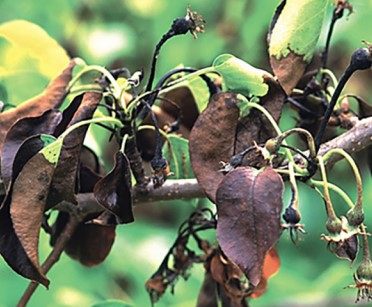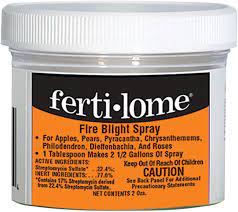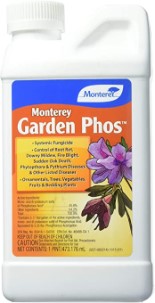Prevent Fire Blight Now, Save Time and Money Later!

Fire blight is a bacterial disease that affects plants in the rose family including: apple, pear, crabapple, hawthorn, flowering pear, cotoneaster, mountain ash, quince, rose, pyracantha, and spirea. It can rarely infect raspberries and cherry trees as well in heavy disease years. The bacteria over winters in cankers which split open in very early spring and ooze a sticky goo. New bacterial infections start from this ooze, and is commonly spread to new shoots and blossoms by insects, wind, and wind-blown rain. It can also be spread by contaminated pruning tools carrying the bacteria from an infected tree.
The blossoms are usually the first to become infected, as they open when temperatures are warmer and spring rains happen regularly. The bacteria multiply and spread rapidly in the blossom nectar and when wind or rain splashes on the blossom, then the bacteria is moved from the stamen into the cup of the blossom and enters the tree at that point. Succulent new shoots are also highly susceptible to bacterial infection, and are more likely to occur after a flush of new growth in the spring accompanied by warm daytime temperatures and higher humidity. When infected, the tender tips wilt and die, forming the characteristic damage of the shepherd’s crook. These types of infections can often kill 12-24 inches of the terminal growth, and in many instances, the leaves and shoots will turn a rusty brown or black color. It’s also common for the leaves to remain attached to the dried shoots and not fall off the tree.
As the tree growth slows and as the temperatures rise in early summer, the progress of the bacteria slows as well. The bacteria can settle and “rest” in infected shoots, right where the dead and healthy tissue meet on a branch or twig. This bacteria will stay dormant in the tissue until the trees begin growing again and the temperatures rise the following spring.
Avoid over fertilization with nitrogen fertilizers later in the growing season as it may promote excessive new growth that is susceptible to fire blight infection.
Symptoms to watch for:
-Scorched appearance of leaves, blossoms, and young terminal shoots.
-Damaged leaves and stems commonly turn rusty brown or black.
-Infected ends of shoots exhibit a typical curling on the end that appears like a shepherd’s crook.
-Small droplets of amber colored bacterial ooze appear on infected branches and twigs.
During the dormant season, remove any cankers or blighted tissue, as well as any suckers growing from the roots or on the lower sections of the trunk. Always cut an infected branch at least 8-12 inches below the last visible injury or canker. Remove blighted blossoms and twigs as soon as they are evident. Sterilize all pruning equipment before making any cuts, and disinfect the tools between cuts when pruning out active fire blight in the late spring or early summer. Bleach is corrosive to pruning tools, so make sure to clean and oil your tools after the pruning is done. Many home gardeners use a 9:1 mixture of water to bleach. Hydrogen Peroxide is also an excellent disinfectant and does less damage to your tools and the environment. To substitute the peroxide for the bleach, use the same ratio when mixing.
Fortunately for the home gardener, there are options to help prevent Fire Blight bacteria from entering your trees.

Ferti-lome Fire Blight Spray is an antibiotic containing streptomycin. It can be applied at the start of the blossoming period and then again every 4-7 days, depending on rain conditions. Every time it rains during bloom season, make your application right before each storm to keep the bacteria from multiplying and spreading.
Natural Guard Copper Soap can also be used as a preventative application for the Fire Blight bacteria. Make one application just prior to bud break, one during bloom season, and again just after blossom drop.

Monterey Garden Phos is the only preventative AND curative product on the market for Fire Blight control. It works systemically through the tree and can stop an infection even after it has begun to damage the twigs and branches. It is safe to use on all sorts of edibles, and aside from its antibacterial properties, it actually boosts the plants natural immunity against all kinds of diseases. Originally from Australia, Garden Phos can be used prior to bloom season, and also during the growing season to stop unexpected infections (we still recommend that you prune out any infected tissue as it develops in addition to using the Garden Phos).
You can either apply Garden Phos as a topical spray during dormant, bloom, or growing season. It also can be applied as a basal bark treatment, when it is applied in a heavier concentrate to the trunk (with a bark penetrant) of the affected tree which then absorbs the material in through the bark and sends it to all parts of the tree systemically. Make sure to do your bark treatment 20-30 days in advance of bloom time, to ensure that the antibacterial properties of the product have time to work its way through the entire tree. The Garden Phos does not stop the infection from occurring systemically, but halts it early in its progress. We regularly recommend a treatment of the Garden Phos in addition to a preventative spray during bloom for gardeners who consistently fight Fire Blight in their orchards.
Mark’s Tomato Magic Formula!
Having tomato troubles? Want to have the first ripe tomato in the neighborhood? Ever wonder why your tomatoes never ripen? We have the answers for you! Watch Mark explain our Tomato Magic Formula and how to have the biggest, most productive tomatoes ever! With just a few easy steps, you can have productive, disease free, super-tasty tomatoes growing like weeds in your own garden. Click the link below to watch our Tomato Magic Formula Video.


